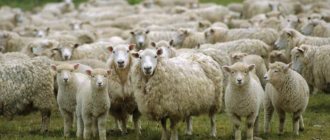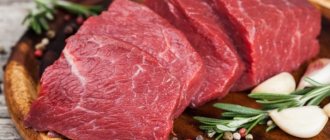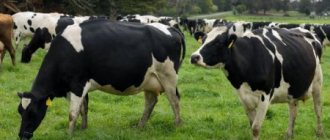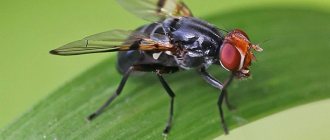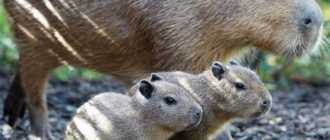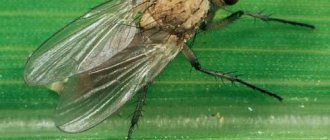Formation of flocks
A flock is a large flock of sheep created by man for their joint maintenance and grazing.
A flock is formed from young lambs. When they grow to a certain age and their mother’s milk becomes insufficient for them, they are gradually united into a herd and taken out to pasture.
For the first couple of weeks, young lambs are isolated from adults. They are kept in a separate pen. When forming flocks, the following factors are taken into account:
- Gender of the animal.
- Age.
- Breed.
- Class.
On large farms there may be flocks formed depending on the color, origin, size of the individual, etc.
Lambs are divided into flocks several months before the next mating of the animals. Before this, the sheep must undergo a medical examination by a veterinarian, receive all necessary vaccinations and get rid of parasites. As a rule, all these procedures are carried out in one day. Otara is a well-coordinated team. Therefore, sheep cope with all procedures quickly, clearly and in order.
What you need to know about grazing
The effectiveness of the scheme depends on how fully the pasture is used. Minimal movement around the pasture is the key to success. Firstly, it is tiring for the animals themselves. Secondly, the sheep need to be given physical rest day and night. This way the roughage they eat is better absorbed.
Grazing of the flock begins early in the morning. To do this, select an area that was used the day before. Hungry sheep will first eat everything offered in that area and then begin to move to neighboring ones.
After the migration, the animals will rest and graze. Then the procedure is repeated.
It is extremely important to complete grazing in the new field. This is necessary so that the flock is not hungry before going to bed and is fully rested.
Pastures are organized near rivers and lakes. Drinking stations are also installed near the grazing area. Animals need to drink more. The daily fluid requirement of a sheep is from 3 to 5 liters.
Sheep are required to receive water in the morning, and this is done until they are completely saturated. The next dose is carried out after each rest.
It is not advisable to drive the herd for watering. It is optimal to bring water to feed the flock.
Drinking from swampy or other stagnant water is unacceptable. In such reservoirs it is easy to become infected with helminths.
Dogs cope with the task along with shepherds
How many sheep are in the flock?
A flock, the definition of the term does not contain specific numbers, consists of many heads of small cattle.
The number of sheep in a herd depends on the size of the farm. The type of herd also affects the number. For example:
- A flock of adult walleyes can reach up to 1000 heads.
- The breeding flock is 850 heads.
- The flock of little lambs is 600-700 heads.
- Breeding lambs are kept the same number as lambs - 600-700 heads.
- The flock of producers is 100 heads.
- Sampler rams – 250 heads.
There are always more production animals in a flock than breeding ones.
Equipment
To ensure the livelihoods of sheep, you need to purchase a number of equipment:
- feeders designed for roughage and wet food;
- drinking bowls in the form of knocked together wooden troughs;
- sheep clippers;
- electric scythe for summer collection of herbs and preparation of food for the winter.
The sale of perishable meat products is possible only if there is spacious refrigeration equipment, so refrigeration units will be required.
You will also have to organize transportation of products. At first, you can hire a truck with special markings. Meat is transported exclusively in special transport, the requirements for which are regulated by sanitary and epidemiological standards (SP2.36.1066-01) and Federal Law No. 29.
Keeping a flock of sheep
Keeping sheep costs farmers much less than keeping any other animals. Sheep are able to find food for themselves even in the remote steppe, which cannot be said about cows, which need high-quality green pastures.
These animals are also unpretentious in housing. The flock spends most of its time in the fresh air, which helps to increase the amount of wool.
At night, the herd is led into pens under shelters to protect them from attacks by predators. In winter, sheep are kept in sheepfolds. They do not represent complex architectural structures. This is a dark room with an adobe floor. Bedding in a sheepfold does not require frequent replacement, because... Sheep waste does not have an unpleasant odor.
From this we can conclude that a flock is the most profitable way to make money from keeping small ruminants.
Breed selection
Most sheep farms in the Russian Federation are engaged in breeding the following breeds:
- Romanovskaya. This is a rough-haired breed. Rams and sheep can reach 100 and 90 kg respectively. Romanov wool is valued for its excellent thermal insulation properties. Young lambs make the best fur coats. The Romanovskys are prolific. For 1 lambing, 3-4 lambs appear, but there are problems with natural lambing. This should be taken into account when constructing premises and organizing supplementary feeding of lambs.
- Edilbaevskaya. The breed belongs to the rough-haired meat-and-fat breed. The weight of a ram can be 145 kg, a sheep - 110 kg. The wool is coarse and is used primarily for making carpets. A special feature of the Edilbaevsky ones is the presence of a fat tail. The weight of tail fat reaches 15 kg. This product is a valuable source of vitamins, but it is necessary to find points of sale, otherwise fat tail fat may be unclaimed. Edilbaevskaya grow quickly, and by 4-5 months they can be ready for slaughter, weighing 45-50 kg. The growth of the herd occurs slowly. The female brings 1-2 lambs, but they are very strong and healthy.
In addition to these breeds, breeding representatives of the meat industry is common:
- Kuibyshevskaya (fine-wool direction);
- Kutamskaya (smooth-haired sheep with rapid weight gain);
- Gorkovskaya;
- West Siberian;
- Suffolk.
Meat products include:
- Tajik;
- Gissarskaya.
Wool breeds:
- Karakul;
- Tushinskaya;
- Grozny;
- Lincoln;
- Merinoland;
- Caucasian
By crossing breeds, farmers get a herd of hardier individuals that quickly gain weight and have satisfactory wool quality.
Replenishment of the flock
A month and a half before mating, the sheep are transferred to a special diet. Her diet includes selected hay, root vegetables, etc. The main thing is to ensure that the sheep does not gain excess weight; nutrition should be complete and balanced. The lamb is pampered with cottage cheese, root vegetables and raw eggs.
Owners have a special attitude towards pregnant sheep. To prevent the expectant mother from having a miscarriage, she should not be frightened, worried or overtired. The diet should be supplemented with chalk and bone meal for an additional source of calcium.
As a rule, sheep do not require assistance during childbirth. But in case of complications, it is better to have the veterinarian’s number at hand. After the lamb is born, the sheep must be given drinking water. Then you need to express the first colostrum, because... it is highly concentrated, which can be harmful to the lamb. And then you can let your baby in for feeding.
You can switch the lamb to adult food after 20 days of life. This should be done gradually, starting with soft hay. The lamb can be put out to pasture in the fourth month of its life. After the lambs have begun to be brought out to pasture, the lambs and lambs need to be resettled. At five months they begin puberty, which can lead to mating of closely related individuals. Incest can result in weak and inferior offspring. Sheep reach sexual maturity at one and a half years.
Why do you dream about Herds of Sheep according to the Ancient Dream Book?
If you dreamed that you saw a sheep, then in reality this demonstrates your character in everyday conditions. You are shy, so you are often embarrassed to express your feelings towards your partner. You are unable to express your desires and share information about your passions with your partner. You accept everything that happens patiently and make no attempts to change the situation or improve it. Anything that goes beyond the ordinary and traditional will shock and frighten you. You urgently need to reconsider your feelings and your worldview - otherwise you risk breaking up with your partner.
Sheep care
A flock is not just a herd of sheep. Each of them requires individual care. Because Sheep spend most of their time outdoors; they are subject to systematic attacks by parasites. Baths with the addition of a 1% creolin solution help get rid of ticks.
In the winter season, sheep practically do not leave the stall, so you need to monitor their hooves. They can outgrow, which will cause pain to the animal.
Sheep's wool grows quite quickly, so they need to be sheared systematically. If you have never done this before, then it is better to entrust this matter to professionals. While grooming, you must not frighten the animal or cause it pain. The more comfortable a ram’s first haircut is, the more willing he will be to undergo subsequent ones.
Beware of the Rams
But with rams you should keep your eyes open, since they, as the owners of the harem, will strive to dominate and show their superiority at the first convenient opportunity.
This behavior is especially evident during the hunting season. The rams begin to butt heads and behave aggressively, both towards each other and towards humans. And while sheep and lambs are cute and pleasant to the touch, a blow from a ram's horns can easily cripple a grown man. Therefore, you should never lose sight of the rams, much less turn your back on them.
Features of sheep farming as a business
Thirty to forty years ago, sheep farming was one of the leading branches of agriculture, especially in the Volga region and Central Asia.
During political cataclysms, collective farms and large farms went bankrupt, as a result of which the livestock of small animals decreased fourfold. Currently, the number of animals in Russia is growing again by 2–3% per year, but this is happening mainly due to private and subsidiary farms. Therefore, raising sheep at home as a business has some prospects for beginning farmers who have fertile pastures at their disposal. These are found in abundance in the following regions:
- Ciscaucasia and Caucasus;
- Stavropol and Krasnodar Territories;
- Tatarstan, Chuvashia, Kalmykia;
- Saratov, Volgograd and Astrakhan regions;
- Bashkiria, Orenburg and Chelyabinsk regions.
In the USSR, wool was considered the main product of sheep farming. However, along with the collective farms, the processing plants that purchased raw materials from the population also disappeared. Therefore, farmers today have no choice but to focus on the production of meat and milk, because organic products are actively becoming fashionable. There are other reasons explaining the relevance of this industry:
- Lambs gain 300 g of weight per day, and by the time of slaughter at ten months they already have a marketable weight of 50–70 kg;
- Sheep of productive breeds can give birth to one or two babies twice a year for eight years;
- Adapted animals make do well with a meager food supply and tolerate frosts down to –25°C without harm;
- In Russia, sheep are almost not bred on an industrial scale, and therefore the farmer does not have to fear competition;
- The state considers sheep farming a priority industry, which allows you to think about how to get a grant for farming development.
Sales
Lamb is considered very healthy and is valued higher than pork and beef among gourmets. From the time of birth or purchase of a lamb to the receipt of an adult weighing from 100 to 200 kilograms, it takes about a year. One-year-old individuals can be shorn and sent for slaughter.
To sell wool, you need to find wholesale buyers, most often they are specialized factories located in rural areas. Lamb wool is used for high quality yarn.
It is much easier to establish sales of meat; you can sell sheep by live weight or sell cut meat. You can enter into a contract with a cafe or restaurant that has lamb dishes on their menu. Then the entrepreneur will supply fresh meat on an ongoing basis, receiving a stable profit. Another sales option could be delivery of carcasses to a meat processing plant.
Business registration
Having decided on the site and the desired number of livestock, proceed to registering the activity. A farm can be registered under the same conditions as an individual entrepreneur. Collect a package of documents for the relevant authority:
- a copy and original of the passport, as well as the birth certificate of the person registering the household;
- registration application;
- power of attorney for a multifunctional center (MFC);
- permission from the sanitary station;
- a receipt confirming that you have paid the state fee.
The documents are submitted to the tax authority according to the registration of the applicant. The decision is made within 5 days, after which the data is entered into the Unified State Register of Individual Entrepreneurs.
